... newer stories
Samstag, 5. März 2016
Stefanie Thiedig 由甲: While Waiting 在等待
youjia, 06:41h
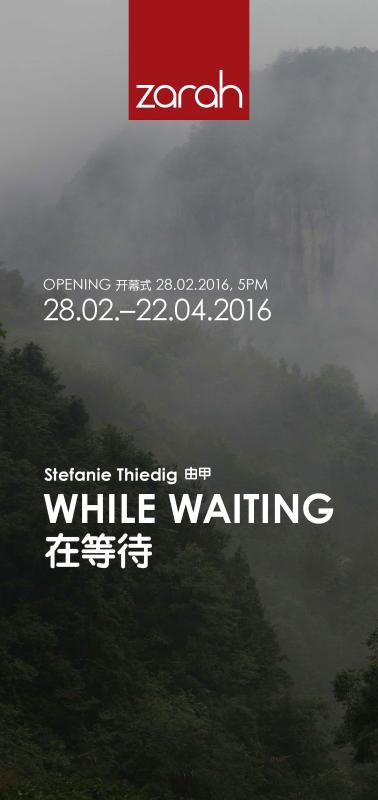
Being in waiting is a condition that appears to be coming back to me. I am usually dismissing it through walking. And then I often take pictures. There are lots of waiting-ways. These pictures could not come out before. But now they are ready. No more waiting for an exhibition!
For the first time not just on my or your computer, but put into materiality. With this choice of pictures opening here, it is a walking into the color of green. Showing you them in winter … all color is gone outside right now, inside we have concrete walls and wooden furniture, not a bad surrounding for my Green Landscapes-walking, I think.
There is no message coming out, instead it is an invitation to come in. Please do come in and wonder around. If you would like to have some theoretical background, I wrote a few passages in our leaflet, also to be found here below – about Hanshan, landscape and void, about walking into them, about nebulae.
在等待中似乎是一种回归我自身的状态。我经常是通过漫步行走的方式去解除这种状态。同时在这个过程中进行拍摄。有很多种等待的方式。这些照片在此之前是不可能出来的。但现在他们多已经成行了。不再需要等待去做一个展览!
第一次不只是在我或你的电脑中去欣赏他们,而是以实物的形式将他们呈现出来。通过今晚所选出这些图片的展现,将带各位在潜入空茫的绿色中漫步行走。在冬天向你们去展现它们……现在外面全部的颜色都失去了色彩,而在里面我们周围这些水泥的墙壁和木制家具座椅,我认为在这样的环境中很适合我的绿色风景中漫步。
在这里没有信息要去向你表达传递,相反,这是一个要身临其境去感受的邀请。请大家都走进来去感受它。如果你想去了解一些背后的理论信息,我也在图册中写了相关的介绍。关于寒山、风景、以及空茫。关于去步入它们,关于蒙雾。
译文:解开缙
Photo exhibition
28-2–22-4-2016
At Zarah
Guloudongdajie No. 46, Dongcheng Beijing
摄影展览
2016年2月28日——4月22日
在Zarah
北京东城鼓楼东大街46号, 010-8403 9807
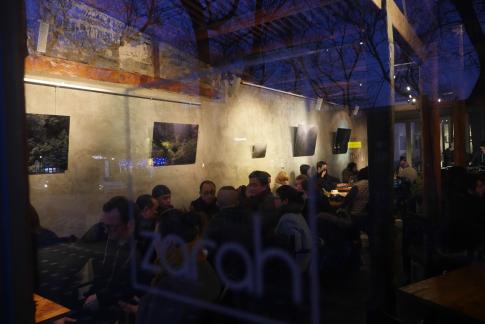
图片 Photo: © Lui Chen 陈路
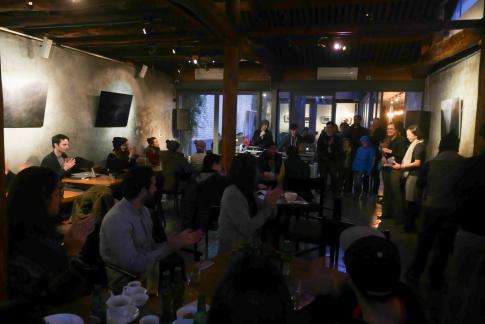
图片 Photo: © Lui Chen 陈路
While Waiting
Waiting for the wind
Waiting for your lover
Waiting for darkness
Waiting for content
To put into context
Waiting for time to deliver
Waiting to calm down
Walking for waiting
Cars passing by
Endless streams of things
Background noise
Blurring away in distance
Numbness inside
Awareness turned off
A flitter of light through the dust
Come along?
I don't want to
I want to keep walking
I don't want this woman to talk to me
Meaningless things
I want to be left alone
In my own meaninglessness
For it to happen?
I don't want it to anymore
I want to be left alone
Diving deep into the color of green
I am not waiting
Not passing time
I keep on walking
Into the color of green
I don't know what time I left
What time it is now
What time I will arrive
I walk straight ahead
Follow the highway
The sun stays in front of me
No need to worry about directions
I don't look back
I don't look up
Emptiness in my head
I don't care about
The monkey running wild
I am going to take a shower
Of course I will be back
1.1.2016, while walking in Beijing
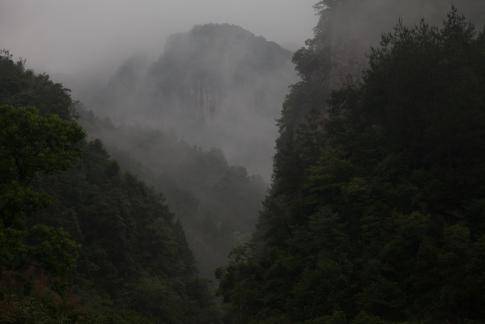
Way to Hanshan 寒山道
Alu-Dibond 铝塑板, 100x67 cm, 2014
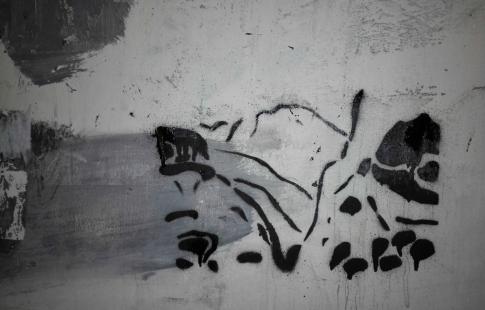
And a small guerilla action in the hutongs …
在等待
等待风
等待你的爱人
等待黑暗
等待内容
去进入语境中
等待时间发酵
等待平静
为了等待而走着
车辆驶过
琐事不停歇地涌来
背景中的噪音
消逝在远处
内心麻痹
意识被屏蔽
一束光线掠过尘埃
跟我走吗?
我不想
我想继续走着
我不想跟这个女人说话
无意义的事情
我想独自一人
在我自己的无意义里
等时间生效?
我不再期望了
我想独自一人
深深潜入绿色中
我不在等待
没有虚度时间
我继续走着
潜入绿色中
我不知道我离开的时间
现在是什么时刻
我何时会抵达
我径直朝前走
沿着高速公路
太阳总在我前方
不用担心方向
我不回头看
我不向上看
头脑空空
我不在乎
猴子肆意张狂
我要去冲个澡
当然我还会回来
2016年1月1日,在北京继续走着
译文:王盼
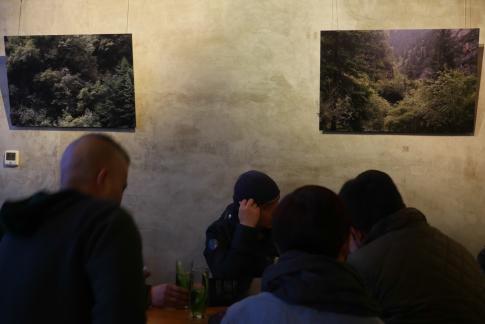
图片 Photo: © Lui Chen 陈路
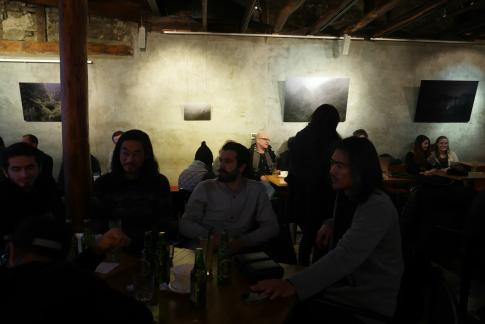
图片 Photo: © Lui Chen 陈路
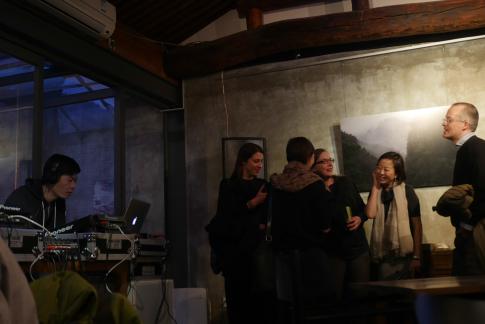
图片 Photo: © Lui Chen 陈路
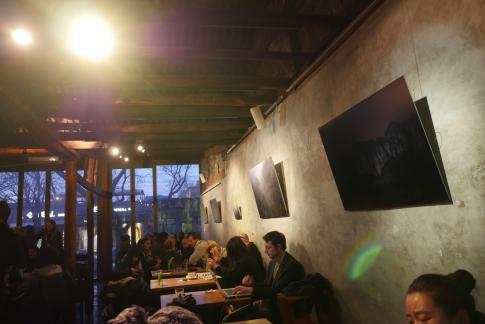
图片 Photo: © Lui Chen 陈路
Hanshan 寒山
Hanshan, Cold Mountain, is an area in the valley of Tiantai mountains in Zhejiang province, after which an otherwise unknown hermit-poet named himself. He lived there in the 7th century in a cave, where he carved his verse into the rocks and the trees nearby. Hanshan was rediscovered through the translation of Gary Snyder as contribution to the Beat generation in the 1950s – and only found his way back to China in recent years via Japan. Hanshan’s ideals of Zen-Buddhist world comprehension and his vernacular ironic malapropism of social mechanisms do not make me want to live without any possessions in the mountains, but they allure me as a pendulum between my life in the Red Dust and the immersion in the waft of mist of forested landscapes.
寒山位于浙江省天台山的寒岩,一位本不知名的诗人遁世与此,并以此山为自己命名。隋末唐初,他居于洞穴中,将诗行刻在岩壁和树干上;二十世纪五十年代,通过加里·斯耐德的翻译,寒山诗受到“垮掉的一代”的推崇,被重新发现。在日本学者的推介下,近年来才再度在中国引起关注。他秉持理想的禅宗的世界观,以白话的表达方式讥讽社会体制。他的诗句并未让我放弃所有去追求山居生活,但着实令我神往——摇摆在滚滚红尘中的世俗生活和森林渺渺雾气中的隐居生活之间。
Hanshan, Kalter Berg, ist ein Ort im Tiantai-Gebirge der Provinz Zhejiang, nach dem sich ein sonst unbekannter Dichter-Einsiedler benannt hat. Dort lebte er im 7. Jahrhundert in einer Höhle und ritzte seine Verse ins Gestein und in die Bäume. Hanshan wurde durch die Übertragung von Gary Snyder als Beitrag zur Beat-Generation der 1950er Jahre wiederentdeckt – und fand erst in den letzten Jahren über Japan erneut seinen Weg nach China. Seine Ideale zen-buddhistischer Weltauffassung und umgangssprachlich ironischer Verballhornung gesellschaftlicher Mechanismen lassen mich nicht in den Bergen und ohne jeglichen Besitz leben wollen, aber sie ziehen mich an – in ein Pendeln zwischen meinem Leben im Roten Staub und dem Eintauchen in die Nebelschwaden von waldiger Landschaft.
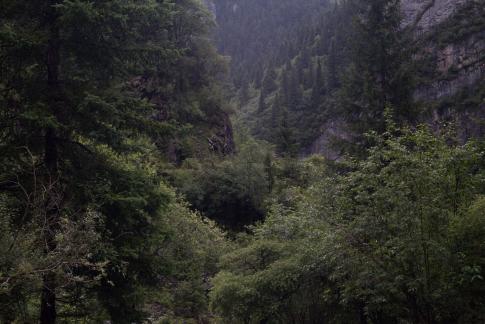
Into the Void 空道
Alu-Dibond 铝塑板, 80x53 cm, 2015
Landscapes 风景
It takes time to get into a landscape, an arrival of one or ten days, a sinking in until one has found a way. The walk differs in the Chinese and Western comprehension of space. It is traditionally aligned with vanishing points on the horizon in the Western sense, which one may also walk into, but where the elements mostly move out of towards oneself. The perspective of Chinese landscapes is not linear, but multiple in height, depth and level. One first let’s the eyes wander in search for an entry, for then to get in and stroll around. One may at any order settle somewhere, rest a while where it pleases and lets the mind drift freely. It is more about perception of spatial continuum in it’s context.
若想真正抵达一片风景,需要花费时间,一段一天或者十天的旅程,被接纳,直到找到一条路。中国对于空间的理解异于西方。在西方传统中,消失点位于地平线上,在这里也可以进入,但通常情况下,所有元素都指向观者。中国山水画的视角并不是线性的,而是讲究高远、深远和平远的多重视角。首先,用眼睛寻觅到一个入口,而后去到那里,开始漫步。可以随心所欲地停下来,逗留片刻,让思想自由驰骋。一切更关乎自身语境中空间连续性的观念。
Es braucht Zeit, um in eine Landschaft hineinzugelangen, eine Anreise von einem oder zehn Tagen, ein Einlassen, bis man einen Weg gefunden hat. Diesen begeht man im chinesischen Raumverständnis anders als im westlichen. Im westlichen gibt es traditionell einen an Fluchtpunkten ausgerichteten Horizont, auch hier kann man hineingehen, aber meistens bewegen sich die Elemente auf einen zu. Die chinesische Landschaftsperspektive ist nicht linear, sondern multipel in Höhe, Tiefe und Weite. Zunächst lässt man den Blick auf der Suche nach einem Einstieg schweifen, um sich dann hineinzubegeben und dort zu wandeln. Man kann sich beliebig niederlassen, bei Gefallen eine Zeit verweilen und seinen Gedanken freien Lauf lassen. Es geht mehr um die Vorstellung des Raumkontinuums in seinem Kontext.
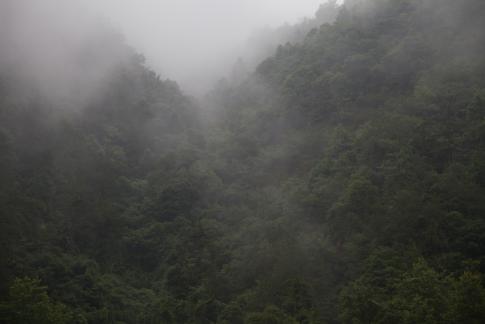
In Nebula 入雾
Alu-Dibond 铝塑板, 100x67 cm, 2014
Void 空
The context may then be forgotten when inside the landscape. One of the best assistants is the mist. Not as empty surface, rather as diffusion from the one here to the other. Kong, the void, serves as medium for this transition. With merging in it, the initial is set to let go, to get absorbed into it. Where to, what, how, asks rationality – and one again is outside. Between being and not being one dives in anew, though to focus through Kong on particular strings of the whole muddle around. Open in departure and applied as a search, nebula might lift up and the ideas whirling in the ether can be grasped. They could still appear as dwelling in a waiting position, but develop on closer inspection an independent existence.
身处风景中,就可以忘掉语境。最好的协助之一就是雾。雾并不就是空旷,而是从一个到另一个区域的过度。空,是服务于这种过度的媒介。随着进入,开始已定,心无旁骛,便可完全融入其中。去向哪里?什么?怎样?理智在质问——又重新置身其外了。重新沉浮在“有”和“无”之间,试图透过“空”,去将焦点投射到一团乱麻中的丝丝缕缕上。出路未知,在探寻中,眼前的云海层层散开,满空中飘浮的想法即会显现,伸手便可捕捉到。它们看似在静默地等待着,然而持续近观之,就会发现,却都独善其身地存在着。
In der Landschaft dann kann der Kontext vergessen werden. Einer der besten Gehilfen ist der Nebel. Nicht als leere Fläche, eher als Diffusion vom einen Hier zu einem anderen. Das Kong, die Leere, dient als Medium für diesen Übergang. Mit dem Hineinbegeben ist der Anfang getan, im Loslassen kann man sich hineinsaugen lassen. Wohin, was, wie, fragt die Ratio – und schon ist man wieder draußen. Zwischen Sein und Nichtsein tauche man erneut ein, um durch das Kong den Fokus auf einzelne Stränge des Gesamtwirrwarrs zu richten. Offen im Ausgang und als Suche angelegt, vermag sich der Nebel vielleicht zu lichten und die im Äther schwirrenden Ideen aufzugreifen. Noch mögen sie in Warteposition verfallen wirken und entwickeln doch bei längerem Hinsehen ein Eigenleben.
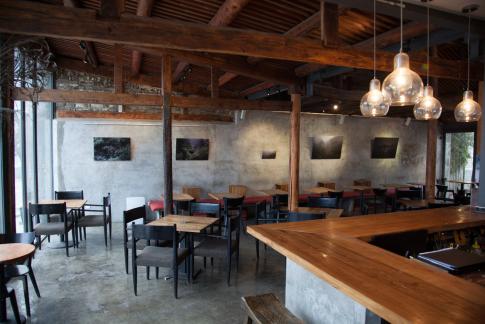
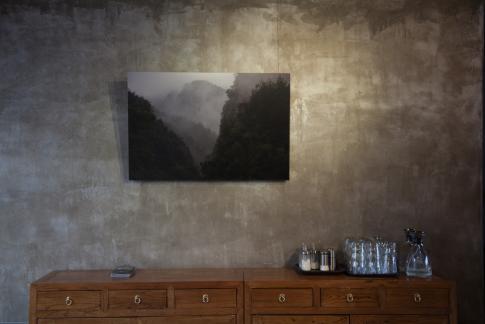
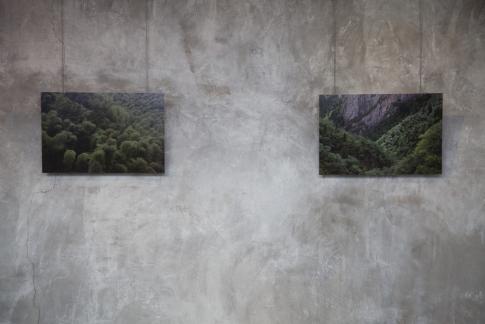
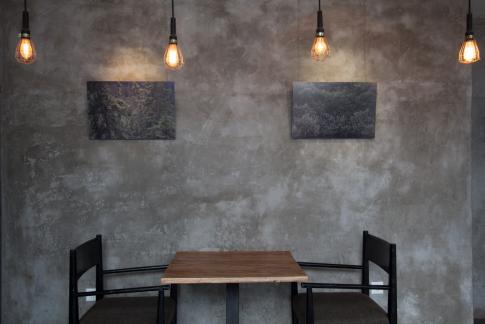
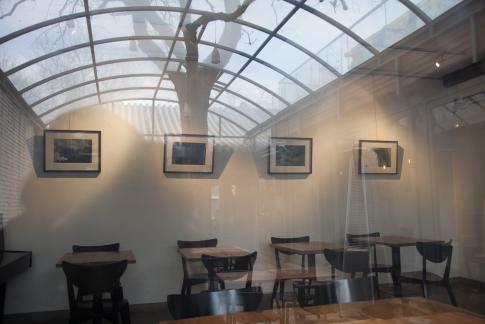
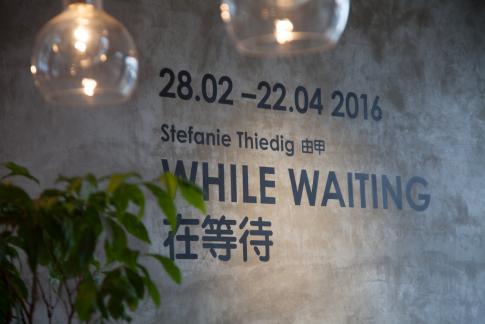
Never heard of the Red Dust, hongchen 红尘? It is the Chinese term for our worldly illusion, in which we find ourselves in everyday life.
译文:王盼
English edit: Lui Chen
Tags für diesen Beitrag 这本文章的标签: Ausstellung 展览, Fotografie 摄影, Beijing 北京, Häufig gelesen 频看
... link (0 Kommentare) ... comment
... older stories